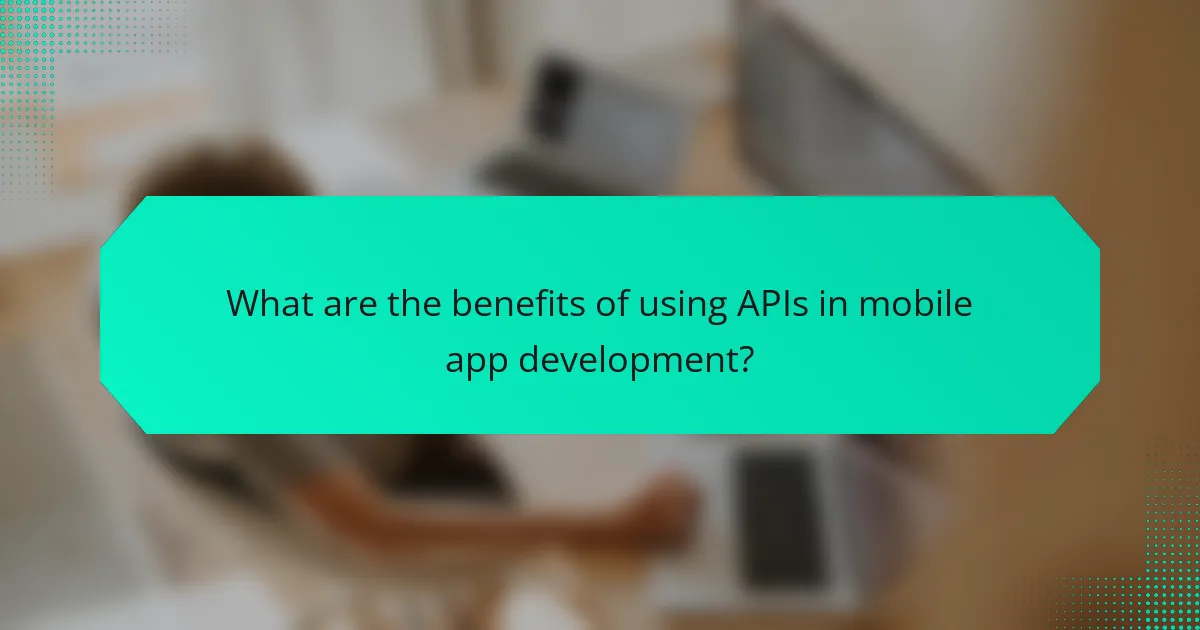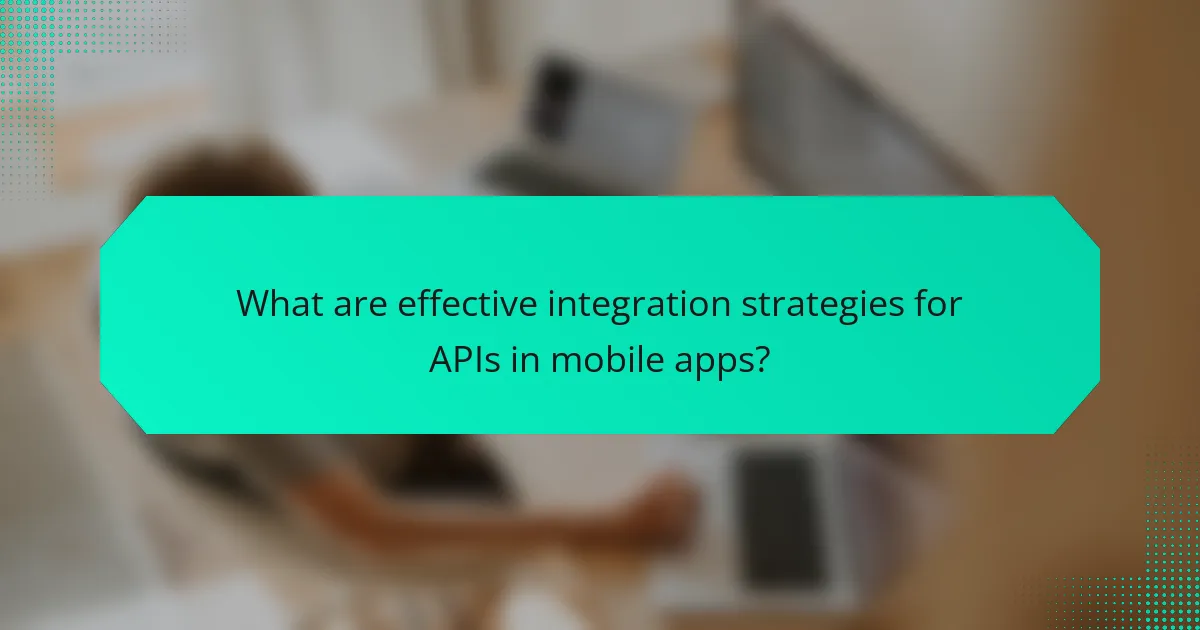APIs, or Application Programming Interfaces, are essential tools that enable software applications to communicate and integrate with various services, significantly enhancing mobile app development. This article explores the role of APIs in mobile applications, detailing their benefits such as seamless integration, improved user experiences, and accelerated development cycles. Key integration strategies, including the use of RESTful APIs and robust authentication methods, are also discussed to ensure efficient data handling and security. With a focus on how APIs support scalability and functionality, this overview provides valuable insights into their critical importance in modern app development.

What are APIs and why are they important in mobile app development?
APIs, or Application Programming Interfaces, are sets of rules that allow different software applications to communicate. They enable mobile apps to access features or data from other services or platforms. APIs facilitate integration with external services like social media, payment gateways, and cloud storage. This integration enhances app functionality and user experience. For instance, using a payment API allows apps to process transactions securely. APIs also enable developers to save time by reusing existing functionalities rather than building from scratch. According to a survey by ProgrammableWeb, over 70% of developers use APIs to enhance their applications. Thus, APIs are crucial for efficient mobile app development.
How do APIs function in the context of mobile applications?
APIs function in mobile applications by enabling communication between the app and external services. They allow apps to request and exchange data with web servers. This interaction is crucial for accessing features like databases, user authentication, and payment gateways. APIs standardize these requests using protocols like REST or SOAP. For instance, a weather app uses an API to fetch real-time weather data from a remote server. This process involves sending a request to the API endpoint and receiving data in a structured format, such as JSON. According to a 2020 survey by Postman, 83% of developers reported using APIs to enhance functionality in mobile applications. Thus, APIs are essential for integrating various services and improving user experience.
What are the key components of an API?
The key components of an API include endpoints, methods, request and response formats, authentication, and documentation. Endpoints are the specific URLs where API requests are sent. Methods define the actions that can be performed, such as GET, POST, PUT, and DELETE. Request and response formats specify the data structure, commonly using JSON or XML. Authentication ensures that only authorized users can access the API, often implemented through tokens or API keys. Documentation provides detailed information on how to use the API, including examples and error codes. These components work together to facilitate communication between different software applications.
How do APIs enable communication between different software systems?
APIs enable communication between different software systems by providing a set of rules and protocols. These rules define how software components should interact. APIs facilitate data exchange, allowing disparate systems to request and send information. For example, a mobile app can use an API to retrieve data from a server. This process involves sending a request to the server’s API endpoint. The server processes the request and responds with the requested data. APIs ensure that the data is formatted correctly for the requesting system. This structured interaction promotes interoperability between various software applications. According to a study by ProgrammableWeb, APIs have become essential for modern software development. They streamline integration and enhance functionality across platforms and devices.
What types of APIs are commonly used in mobile app development?
Common types of APIs used in mobile app development include REST APIs, SOAP APIs, and GraphQL APIs. REST APIs are widely adopted due to their simplicity and use of standard HTTP methods. SOAP APIs offer a protocol for exchanging structured information, often used in enterprise applications. GraphQL APIs provide a flexible query language, allowing clients to request specific data. Additionally, third-party APIs like social media and payment gateways are frequently integrated. These APIs enhance functionality and improve user experience in mobile applications.
What are the differences between RESTful and SOAP APIs?
RESTful APIs are architectural styles that use standard HTTP methods, while SOAP APIs are protocol-based and rely on XML messaging. RESTful APIs are stateless and can return data in multiple formats, including JSON and XML. In contrast, SOAP APIs require a strict contract defined by WSDL and are typically more complex. RESTful APIs are generally easier to use and integrate with web services. SOAP APIs provide higher security features through WS-Security. RESTful APIs are more suited for mobile applications due to their lightweight nature. SOAP APIs are often used in enterprise environments requiring high reliability and transaction support.
How do public, private, and partner APIs differ?
Public APIs are available to any developer and are designed for widespread use. They allow third-party developers to access certain features or data from a service. Examples include social media APIs like Twitter and Facebook. Private APIs are intended for internal use within an organization. They help streamline operations and improve integration among internal systems. Partner APIs are shared with specific business partners. They offer controlled access to features or data, often under a partnership agreement. These APIs facilitate collaboration between businesses while maintaining security and privacy. Each type serves a distinct purpose, catering to different audiences and use cases.

What are the benefits of using APIs in mobile app development?
APIs in mobile app development provide several key benefits. They enable seamless integration of third-party services, enhancing functionality without extensive coding. APIs facilitate data exchange between applications, allowing for real-time updates and improved user experiences. They promote faster development cycles by reusing existing services and features. APIs also support scalability, enabling apps to grow and adapt to user needs. Furthermore, they enhance security by allowing controlled access to data. A study by ProgrammableWeb highlights that 83% of developers use APIs to accelerate application development.
How do APIs enhance app functionality?
APIs enhance app functionality by enabling seamless communication between different software systems. They allow apps to access external services, databases, and features without needing to build them from scratch. This integration leads to improved user experiences and expanded capabilities. For example, a weather app can use a weather API to provide real-time data. Similarly, payment APIs allow e-commerce apps to process transactions securely. APIs also facilitate the incorporation of social media features, enhancing user engagement. Overall, APIs are crucial for adding diverse functionalities efficiently and effectively in mobile app development.
What role do APIs play in integrating third-party services?
APIs facilitate the integration of third-party services by enabling communication between different software systems. They provide a standardized way for applications to request and exchange data. This allows developers to leverage external functionalities without building them from scratch. For instance, APIs can connect mobile apps to payment gateways, social media platforms, or cloud services. By using APIs, developers can enhance app features and improve user experience. According to a report by ProgrammableWeb, over 20,000 APIs are available, showcasing their widespread use in various industries. Thus, APIs are essential for seamless integration and functionality expansion in mobile app development.
How can APIs improve user experience in mobile apps?
APIs can improve user experience in mobile apps by enabling seamless integration of external services. They allow apps to access functionalities like payment processing, social media sharing, and data retrieval. This integration enhances convenience for users. For example, using a payment API can simplify transactions, reducing friction during purchases. Additionally, APIs can provide real-time data updates, ensuring users have the latest information. A study by Apigee found that 83% of developers believe APIs enhance user engagement. Overall, APIs streamline processes and enrich app functionality, leading to a better user experience.
What impact do APIs have on development efficiency?
APIs significantly enhance development efficiency. They allow developers to integrate existing functionalities rather than building them from scratch. This reduces the time and resources needed for development. APIs facilitate faster iteration and prototyping. According to a report by MuleSoft, 83% of developers believe APIs improve productivity. Furthermore, APIs enable better collaboration among teams. This streamlines workflows and reduces redundancy in coding tasks. Overall, APIs are crucial for accelerating the development process.
How do APIs facilitate faster development cycles?
APIs facilitate faster development cycles by enabling seamless integration of third-party services and functionalities. They allow developers to access pre-built components, reducing the need to create features from scratch. This accelerates the coding process and minimizes errors. APIs also promote collaboration among teams by providing clear interfaces for interaction. According to a study by ProgrammableWeb, using APIs can decrease development time by up to 30%. This efficiency leads to quicker iterations and faster deployment of applications. Overall, APIs streamline workflows and enhance productivity in mobile app development.
What are the cost benefits of using APIs in mobile development?
Using APIs in mobile development reduces costs significantly. They allow developers to leverage existing services and functionalities. This minimizes the need to build features from scratch. Consequently, development time is shortened, leading to lower labor costs. APIs also enable easier integration with third-party services. This can reduce expenses related to infrastructure and maintenance. For example, using payment processing APIs can eliminate the need for complex security compliance. Studies show that companies utilizing APIs can save up to 30% on development costs. Overall, APIs offer a cost-effective solution for enhancing mobile applications.

What are effective integration strategies for APIs in mobile apps?
Effective integration strategies for APIs in mobile apps include using RESTful APIs, implementing robust authentication methods, and ensuring efficient data handling. RESTful APIs provide a standardized way to communicate between the app and server, enhancing compatibility. Robust authentication methods, such as OAuth, secure user data and maintain privacy. Efficient data handling involves optimizing API calls to minimize latency and improve user experience. Implementing caching strategies can also reduce the number of API calls, further enhancing performance. Additionally, thorough documentation and version control are crucial for smooth integration and future updates.
How can developers choose the right API for their mobile application?
Developers can choose the right API for their mobile application by evaluating several key factors. First, they should assess the API’s functionality to ensure it meets their application needs. Next, they must consider the API’s documentation quality. Well-documented APIs facilitate easier integration and troubleshooting.
Additionally, developers should evaluate the API’s performance and reliability. High availability and fast response times are critical for user satisfaction. Security features are also essential; APIs should offer robust authentication and data protection mechanisms.
Cost is another important consideration. Developers should analyze pricing models to ensure they align with their budget. Lastly, community support and user reviews can provide insights into the API’s usability and effectiveness. These factors collectively guide developers in selecting the most suitable API for their mobile applications.
What factors should be considered when evaluating an API?
When evaluating an API, several factors should be considered. These include documentation quality, which ensures developers can easily understand and implement the API. Performance metrics such as response time and throughput are critical for efficiency. Security features like authentication methods and data encryption protect sensitive information. Compatibility with existing systems ensures seamless integration. Support and community engagement can provide assistance and resources. Pricing models should be evaluated for cost-effectiveness. Lastly, versioning and update policies impact long-term usability and maintenance. Each factor plays a vital role in determining the API’s overall suitability for a project.
How do security and reliability affect API selection?
Security and reliability are critical factors in API selection. APIs must ensure data protection and prevent unauthorized access. A secure API uses authentication and encryption to safeguard sensitive information. Reliability involves consistent performance and availability of the API. An unreliable API can lead to application failures and user dissatisfaction. According to a survey by SmartBear, 90% of developers prioritize security in API selection. Furthermore, 70% of developers report that reliability directly impacts their choice of API. Therefore, both security and reliability significantly influence the decision-making process when selecting APIs for mobile app development.
What best practices should be followed during API integration?
Best practices during API integration include thorough documentation review. Understanding the API’s endpoints and parameters is crucial. Implementing error handling ensures smooth operation. Use versioning to manage changes effectively. Secure API keys to protect sensitive data. Monitor API performance to identify issues early. Testing in a sandbox environment helps catch potential problems. Following these practices enhances reliability and user experience.
How can developers ensure smooth API integration in their apps?
Developers can ensure smooth API integration in their apps by following best practices. First, they should carefully read the API documentation. Comprehensive documentation provides guidance on endpoints, request formats, and authentication methods. Second, developers should use tools like Postman for testing API calls. This helps identify issues before integrating the API into the app. Third, they should implement error handling in their code. Proper error handling can manage unexpected responses from the API. Fourth, developers should consider using versioning for APIs. This ensures compatibility with future updates. Additionally, they can utilize libraries and SDKs provided by API developers. These resources simplify integration and reduce errors. Lastly, thorough testing of the app with the API is essential. Testing helps confirm that all functionalities work as intended. Following these practices leads to a more reliable API integration process.
What common pitfalls should be avoided when integrating APIs?
Common pitfalls to avoid when integrating APIs include poor documentation, which can lead to misunderstandings. Lack of version control can cause integration issues as APIs evolve. Ignoring error handling may result in unhandled exceptions during runtime. Failing to authenticate properly can expose applications to security risks. Overlooking rate limits can lead to service disruptions. Not testing in a staging environment can introduce bugs into production. Lastly, underestimating the importance of performance monitoring can hinder the identification of issues. Each of these pitfalls can significantly affect the success of API integration.
What troubleshooting tips can help with API integration challenges?
Check API documentation for accuracy. Ensure endpoint URLs and parameters are correct. Test API responses using tools like Postman or CURL. Validate authentication tokens and permissions to avoid access issues. Monitor network activity for latency or failures during requests. Implement logging to capture error messages for analysis. Review error codes returned by the API for specific guidance. Consult community forums or support channels for additional insights and solutions.
APIs, or Application Programming Interfaces, are critical components in mobile app development, facilitating communication between applications and external services. This article explores the various types of APIs, including REST, SOAP, and GraphQL, and their significance in enhancing app functionality and user experience. Key benefits of using APIs include improved development efficiency, cost savings, and seamless integration of third-party services. The article also outlines effective integration strategies, best practices for API selection, and common pitfalls to avoid during the integration process, ensuring developers can leverage APIs effectively in their mobile applications.


